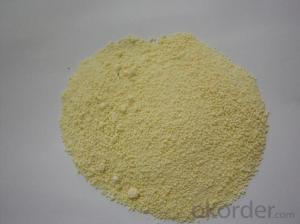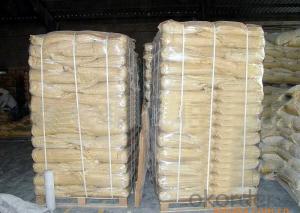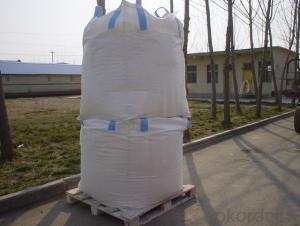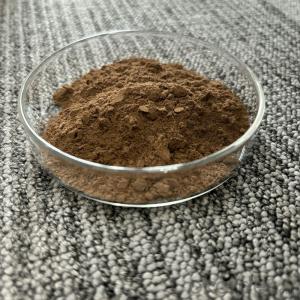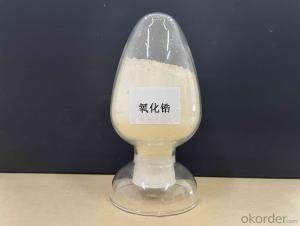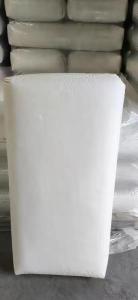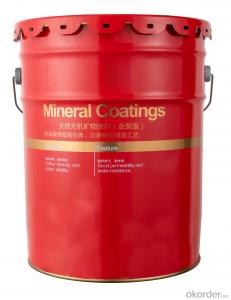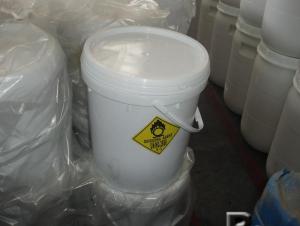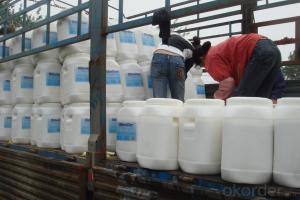RUBBER VULCANIZING ACCELERATOR MBTS (DM)
- Loading Port:
- Tianjin
- Payment Terms:
- TT OR LC
- Min Order Qty:
- 25 m.t.
- Supply Capability:
- 12000 m.t./month
OKorder Service Pledge
OKorder Financial Service
You Might Also Like
RUBBER VULCANIZING ACCELERATOR MBTS(DM)
Chemical Name: Dibenzothiazole disulfide
Molecular Formula: C14H8N2S4
Molecular Weight:332.50
CAS NO. : 120-78-5
Executive standard:GB/T 11408-2003
Specification:
| Index | ||
High-class products | First-class products | Acceptable end-product | |
Appearance(Visual inspection) | White or light yellow powder, granular | ||
Initial M.P, oC ≥ | 170.0 | 166.0 | 162.0 |
Loss on drying, % ≤ | 0.30 | 0.40 | 0.50 |
Ash, % ≤ | 0.30 | 0.50 | 0.70 |
Residues on 150μm sieve,% ≤ | 0.00 | 0.10 | 0.10 |
Properties: white or light yellow powder (granule) with a little bitter, no poison. The density is 1.50, Melting point above 170℃,slightly soluble in benzene, chloroform and ethanol, is not soluble in water petrol. And ethyl acetate. Good storage stability.
Application: Given flat, moderately fast cures in NR and SR. Also used in a wide range of general purpose rubber. Non-staining and non-discolouring in "white" socks; used as a plasticizer and retarder in polychloroethylene rubber. Secondary acceleration is usually required for synthetic polymers. Better scorch safety than MBT.
Packaging: 20kg plastic woven bag, paper with plastic film bag, kraft paper bag or jumbo bag.
Storage: e product should be stored in the dry and cooling place with good ventilation, avoiding exposure of the packaged product to direct sunlight. The validity is 2 years.
Note: The product could be ultra fine powder based on customer accurate requirement.
- Q:What is the similarity between enzymes and general chemical catalysts?
- (1) The enzyme is the same in many respects as a biocatalyst and a general catalyst, such as a small amount and a high catalytic efficiency. As with the general catalyst, the enzyme can only change the rate of chemical reaction and does not change the equilibrium of the chemical reaction It is possible to catalyze the activation of a large number of substrates in a short time and to reflect the high efficiency of enzyme catalysis.The enzyme can reduce the activation energy of the reaction (activation) (△ G) during the reaction, but the reaction rate is accelerated and the reaction time is reduced, but the equilibrium constant is not changed. (2) However, the enzyme is a biological macromolecule (1) Enzyme-catalyzed high efficiency: The catalytic effect of the catalyst can increase the reaction rate by 10 ^ 6 ~ 10 ^ 12 times, which is at least several times higher than that of the conventional catalyst. (2) The enzyme catalyst Highly specificity: including specificity of response, substrate specificity, chirality specificity, geometric specificity, etc., that an enzyme can only act on a certain class or a specific substance. Bond, ester bond, peptide bond and so on can be catalyzed by acid-base hydrolysis, but the hydrolysis of these chemical bonds are different, respectively, the corresponding glycosidase, esterase and peptidase, that is, they were specific (3) enzymatic reaction conditions are mild: enzymatic reaction is generally carried out in aqueous solution of pH = 5 ~ 8, the reaction temperature range is 20 ~ 40 ℃
- Q:give an example of how a catalysts speeds up the rate of reaction?? thank you!!?
- I like the hydrogen peroxide answer, but I just ran out of MnO2 at my house, I guess I will just have to pour some H2O2 into the small cut I have. The bubbles you see are oxygen gas which is formed by the decomposition of the H2O2 catalyzed by the peroxidase enzyme in your blood.
- Q:Several experiments were carried out using catalysts
- Hydrogen peroxide in the manganese dioxide as a catalyst for decomposition reaction: 2H2O2 == MnO2 == 2H2O + O2 ↑ (laboratory oxygen principle)
- Q:In the presence of catalyst, KCl is produced in the thermal decomposition of KClO3.You did not have a catalyst. Did you get the same products for this reaction as you would have with a catalyst?
- A catalyst changes the RATE of a reaction, not the products. So, yes, you get the same products without the catalyst as you do with the catalyst.
- Q:how could scientists know the exact catalyst for every reactions??? THANX sooo much
- Believe me, nema, there's no way that we chemists know the best catalyst for every reaction. That would be simply impossible. However, from the type of reaction, the reactants, products, reaction conditions, solvents, etc. and from one's experience and the literature (papers and patents) one can get a good idea for most reactions of the type of catalyst that has worked for similar systems. One then starts off with a catalyst from the literature and modifies or changes it if improvement is needed based on chemical principles that one learns. There are also some theoretical calculations that can be made. Sometimes they work and sometimes they don't :) If it is an industrially important process like the Haber process for making ammonia from nitrogen gas and hydrogen gas, there may be thousands of catalysts which have been tried and evaluated. New minor improvements are being made every day. When a company does find a very good catalyst for an important reaction, often they keep it a trade secret. The good catalyst can make a huge difference in how commercially successful a particular process is. That's a large part of what chemical engineers do. You may never know if you have the best catalyst. The most you can hope for is one that is good enough. So it's a few parts personal knowledge, a few parts literature, a couple of parts theory, a lot of experimentation and often, more than not, a little luck. :)
- Q:Chemical reaction in the presence of catalyst for the reaction are carried out a high life
- Theoretically are carried out, but some of the reaction is relatively slow, so we classified it as non-response, the catalyst is only to speed up or slow down the reaction rate of the reaction itself does not affect the reaction. I'm on high school.
- Q:woulld you be able to answer these aswell i really dont know how to do this cehmestryExplain how, and why, an atom of chlorine (Cl) and an atom of lithium (Li) would form a chemical bond with each other. (iii)Explain what is meant by electronegativity and how it can be used to determine the nature of a chemical bond. (iv)Write a note outlining what is meant by vapor pressure and explain how the concept is used to define the boiling point of a liquid.
- Because of the production of photochemical oxidants from NOx reacting with hydrocarbons in sunlight Noxer blocks are used to rid the NOx from the surroundings through The titanium dioxide (TiO2) on the bocks absorbs ultra-pink radiation from daylight which excites its electrons to a bigger orbital. On the outside of the crystals of TiO2 a reaction happens between oxygen and a high power electron from the TiO2. O2 + e? --O2 ? The excessive vigor electron is then given back to the TiO2 when water then reacts with the oxygen to present H2 O + O2 --H+ + O2 ? + OH Nitrogen dioxide is oxidised to nitrate ions as a result of the hydroxyl radical being an awfully strong oxidising agent NO2 + OH --H+ + NO3 ? The superoxide from response 3 also varieties nitrate ions from nitrogen monoxide. NO + O2 ? --NO3 ? This nitrate is washed away through rain or combines with the concrete within the block.
- Q:Is it possible for the different chemical reactions to have the same catalyst?
- Right, think about the catalysis of biological enzymes
- Q:Could you please explain it, i know they increase reaction rates but how?
- A catalyst lowers the activation energy (the minimum amount of energy needed for a reaction to take place). This means that the particles can react with less energy than they needed before the catalyst was added. (Think about it: if the government lowered the legal age to buy cigarettes, then more people could legally buy cigarettes. Similarly, if we lower the amount of energy needed for particles to react, then more particles can react). Also, a catalyst provides a surface on which the reaction can take place. This increases the number of collisions between the particles of the substances that are reacting.
- Q:What is the difference between biological and chemical catalysts?
- catalysts which catalyze the chemical reactions taking place in human body such as enzymes are called bio-catalyst and other one's which are generally used in laboratory by chemists for multiple type of reactions are chemical ctalysts
1. Manufacturer Overview |
|
|---|---|
| Location | |
| Year Established | |
| Annual Output Value | |
| Main Markets | |
| Company Certifications | |
2. Manufacturer Certificates |
|
|---|---|
| a) Certification Name | |
| Range | |
| Reference | |
| Validity Period | |
3. Manufacturer Capability |
|
|---|---|
| a)Trade Capacity | |
| Nearest Port | |
| Export Percentage | |
| No.of Employees in Trade Department | |
| Language Spoken: | |
| b)Factory Information | |
| Factory Size: | |
| No. of Production Lines | |
| Contract Manufacturing | |
| Product Price Range | |
Send your message to us
RUBBER VULCANIZING ACCELERATOR MBTS (DM)
- Loading Port:
- Tianjin
- Payment Terms:
- TT OR LC
- Min Order Qty:
- 25 m.t.
- Supply Capability:
- 12000 m.t./month
OKorder Service Pledge
OKorder Financial Service
Similar products
New products
Hot products
Hot Searches
